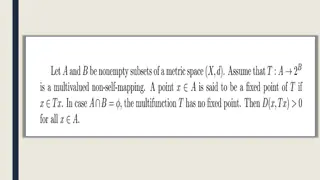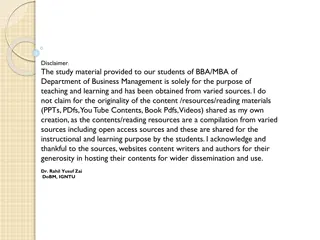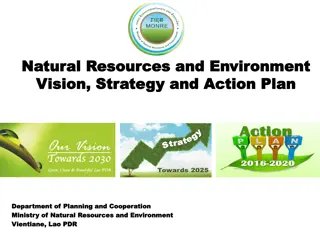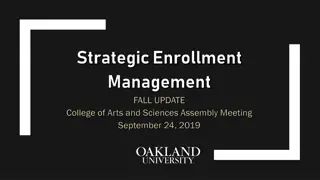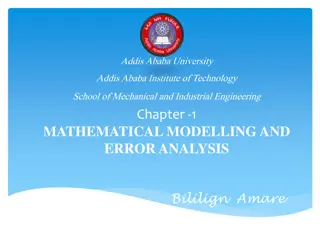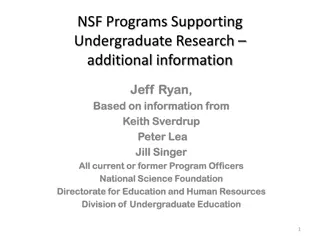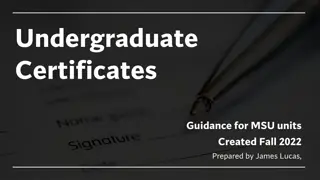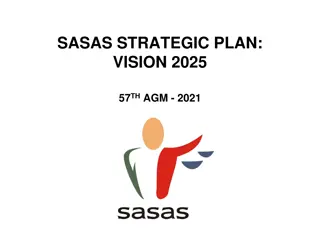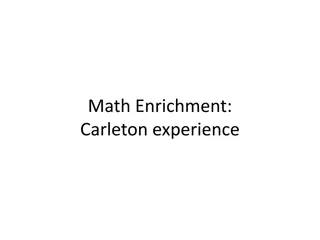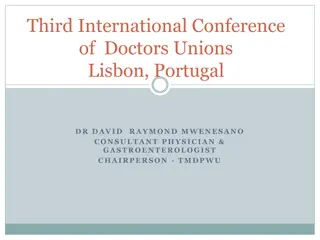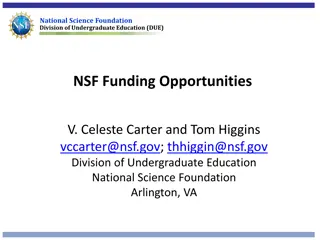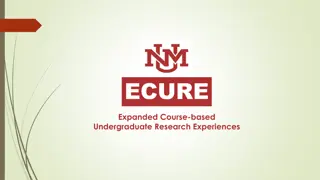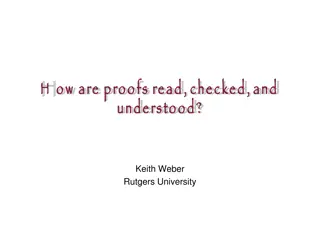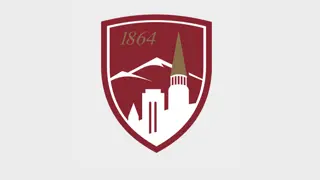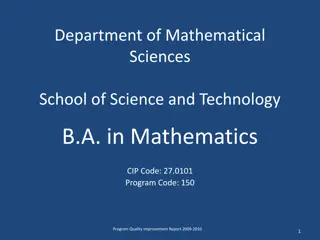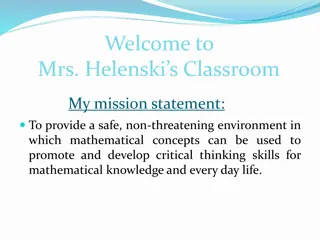A Common Vision for Undergraduate Mathematical Sciences Programs in 2025
Challenges faced by mathematics and statistics programs in preparing scientifically literate citizens, including low success rates, disparities in degree awards for underrepresented minorities, and high failure rates under traditional lecture approaches. Two influential reports criticized the teaching of mathematics to undergraduates, prompting the need for change. The Common Vision Project, funded by the National Science Foundation, aims to modernize undergraduate mathematics programs through shared curricula, instructional methodologies, support structures, and extracurricular opportunities to reflect the evolving nature of the discipline and STEM fields.
Download Presentation

Please find below an Image/Link to download the presentation.
The content on the website is provided AS IS for your information and personal use only. It may not be sold, licensed, or shared on other websites without obtaining consent from the author.If you encounter any issues during the download, it is possible that the publisher has removed the file from their server.
You are allowed to download the files provided on this website for personal or commercial use, subject to the condition that they are used lawfully. All files are the property of their respective owners.
The content on the website is provided AS IS for your information and personal use only. It may not be sold, licensed, or shared on other websites without obtaining consent from the author.
E N D
Presentation Transcript
A Common Vision for Undergraduate Mathematical Sciences Programs in 2025 AMATYC webinar June 21, 2016 Celebrating a Century of Advancing Mathematics
Challenges facing our community Mathematics and statistics courses function as gateways to many majors are crucial for preparing scientifically literate citizens. Yet: Only ~50% of students earn a grade of A, B, or C in college algebra courses. Women are almost twice as likely as men to choose not to continue beyond Calc I, even when Calc II is required for their intended major. References listed in the Common Vision report (link included on a later slide)
Challenges facing our community Mathematics and statistics courses function as gateways to many majors are crucial for preparing scientifically literate citizens. Yet: In 2012: About 20% of all bachelor's degrees were awarded to URM students (9.5% to Blacks, 9.8% to Hispanics). But only about 12% of math bachelor's degrees were awarded to URM students (4.9% to Blacks, 6.4% to Hispanics). Failure rates under traditional lecture are 55% higher than for more active approaches to instruction References listed in the Common Vision report (link included on a later slide)
Impetus to change Two recent reports in particular criticized the collective enterprise of teaching mathematics to undergraduates: Engage to Excel: Producing One Million Additional College Graduates with Degrees in Science, Technology, Engineering, and Mathematics (PCAST, 2012) The Mathematical Sciences in 2025 (NRC, 2013)
Common Vision Project National Science Foundation funded the project in 2014 (NSF DUE-1446000). To develop a shared vision in the mathematical sciences community of the need to modernize undergraduate mathematics programs, especially the first two years. To catalyze grassroots efforts to address the collective challenges we face.
Common Vision Project Program comprises: Curricula (courses, topics, electives) Instructional methodologies Support structures Extra-curricular opportunities
Common Vision Project Modernized programs will: Reflect the changing face of our discipline, especially with respect to inclusion of data science, modeling, and computation. Reflect the increasingly cross-disciplinary nature of STEM fields. Provide a coherent, intriguing introduction to collegiate mathematics for all students.
Common Vision Project Representation from the five professional associations who focus on undergraduate mathematical sciences programs as an integral part of their mission: American Mathematical Association of Two-Year Colleges (AMATYC) American Mathematical Society (AMS) American Statistical Association (ASA) Mathematical Association of America (MAA) Society for Industrial and Applied Mathematics (SIAM)
Common Vision Project Leadership Team Karen Saxe, Principal Investigator, Macalester College Linda Braddy, co-PI, MAA John Bailer, ASA, Miami University Rob Farinelli, AMATYC, College of Southern Maryland Tara Holm, AMS, Cornell University Vilma Mesa, RUME community, University of Michigan Uri Treisman, TPSE, University of Texas at Austin and Charles A. Dana Center for Innovation in Math and Science Education Peter Turner, SIAM, Clarkson University
Common Vision Project Phase 1 of a 2-part initiative Introspective To articulate an internally coherent vision within our community Phase 2 proposed as outward-looking, focused on: Grassroots efforts Efforts that build on existing work Dissemination and implementation of modernized curricula and delivery methods Widespread, large-scale change
Common Vision Project We spent the first six months drafting a report of common themes found in existing curricular guides published by the five associations: Beyond Crossroads, AMATYC, 2006 (update of the 1995 publication Crossroads in Mathematics: Standards for Introductory College Mathematics Before Calculus) Guidelines for Assessment and Instruction in Statistics Education College Report, ASA, 2012 Guidelines for Undergraduate Programs in Statistical Science, ASA, 2014
Common Vision Project We spent the first six months drafting a report of common themes found in existing curricular guides published by the five associations: 2015 CUPM Guide to Majors in the Mathematical Sciences, MAA, 2015 (update of Undergraduate Programs and Courses in the Mathematical Sciences: CUPM Curriculum Guide 2004) Partner Discipline Recommendations for Introductory College Mathematics and the Implications for College Algebra, MAA, 2012 Modeling across the Curriculum, SIAM, 2012 Undergraduate Programs in Applied Mathematics, SIAM, 2014
Common Vision Project May 2015 workshop ~50 participants from higher education institutions, professional associations, business, industry, and government Provided feedback for refining report Drafted proposals for specific initiatives to improve curricula and instruction
Common Vision Accomplishments Published a final report http://www.maa.org/sites/default/files/pdf/common- vision/common_vision_final.pdf Hard copies available upon request (while supplies last) Synthesis of the common themes, based on our research and input from project participants and other leaders in our community Summary of four broad areas that need attention and action from our community: Curricula Course structure Workforce preparation Faculty development
Common Vision Accomplishments Published a final report Foundation for future work Guide for funding agencies best bets for targeted federal investments likely to have transformative impact Call to collective action A coordinated effort supported by major players from all existing sectors is more effective than an array of new initiatives and organizations. (Kania & Kramer, 2011, on collective impact ) Improving teaching and learning requires well-coordinated efforts among faculty, administrators, employers, professional associations, and funding agencies.
Common Vision Accomplishments Published a final report We intentionally did not focus on Developmental/remedial courses K-12 education because we had limited time and financial resources. We reserved those for Phase 2 efforts.
Common Vision Accomplishments Policy efforts White paper sent to John Holdren (OSTP, PCAST), members of Congress, chairs and ranking members of House and Senate committees on education. Calls to action in professional associations publications. Science policy panel with Rush Holt (Congress, AAAS) and Jim Gates (PCAST) at 2016 Joint Mathematics Meetings. Endorsement from the Conference Board of the Mathematical Sciences (www.cbmsweb.org) See www.maa.org/common-vision
Common Vision Report Common Themes in Curricular Guides The status quo is unacceptable More statistics, modeling, simulation, and computation Less traditional lecturing & more active learning techniques (anything that engages students; basically, anything other than traditional lecture) Multiple pathways: Through general education mathematics and statistics requirements Into and through majors in the mathematical sciences Increasing role of two-year colleges
Common Vision Report Common Themes in Curricular Guides Attention to student transitions & transfer between institutions Technology to enhance student learning Curricula development efforts with partner disciplines Emphasis on developing students communication skills Faculty reward systems (e.g., tenure and promotion criteria) are outdated Sustainability of initiatives
Common Vision Report Other Important Themes Themes present in some, but not all, guides Themes that warrant considerable attention Student diversity Our inability to attract and retain a diverse student population in the mathematical sciences is a dreadful shortcoming that must be remedied 1998: Stiff & Harvey called the mathematics classroom one of the most segregated places in the U.S. Today: Upper-level mathematics classes remain predominantly white Today: The performance gap in mathematics is evident as early as 4thgrade It is our responsibility to remove barriers, we should not presuppose minorities and women are less capable or less prepared
Common Vision Report Other Important Themes Student mobility Almost half of all students in four-year institutions have credit on their transcripts from two-year institutions Most prevalent among low-income students We have a shared responsibility across all levels of education, P-20 Contingent faculty Any non-tenure-track position (full-time, part-time, short-term, long-term) More and more . and more and more .. 76% of appointments in higher ed are contingent positions Up to 2/3 in two-year institutions are part-time positions Need professional development and support Graduate teaching assistants Some of the same issues as with contingent faculty
Common Vision Report Other Important Themes Future teachers The specialized knowledge needed for teaching is distinct from the knowledge needed for other math-intensive professions (different, not less) 2001 CBMS MET report 2012 CBMS MET II report Failure rates The high rate of failure in post-secondary math classes is an embarrassment to our profession Math courses are the most significant barrier to degree completion in all fields
Common Vision Report Other Important Themes Developmental courses 60% of entering community college students Most students (70% at CC s) deemed unready for a credit-bearing math course will never graduate Calculus Technology enabled delivery methods Assessment Scaling (broader issue related to sustainability)
Common Vision Report Recommendations for the Community at Large Update curricula Scale up the use of evidence-based pedagogical methods Articulate clear pathways between curricula at the K-12 level and the first courses students take in college Find ways to remove barriers facing students at critical transition points (e.g., placement, transfer) Establish stronger connections with other disciplines Additional recommendations are included for specific stakeholders
Common Vision Report Call to Action To ensure students graduate with skill sets to match expectations of prospective employers, our community must modernize curricula with input from representatives in partner disciplines, business, industry, and government. While intellectual domains fragment and coalesce over time, a central task for mathematics faculty at institutions of higher education, and more broadly, the mathematical sciences community as a whole, is to create a coherent, intriguing introduction to collegiate mathematics for all students.
Common Vision Report Call to Action This work should aim to narrow the gap between mathematics as practiced in the academy and other employment sectors and mathematics as experienced in higher education's instructional programs.
Common Vision Report Call to Action Common Vision built on the work of the INGenIOuS project, and we also reiterated a call to action from their report (Zorn, et al, 2014): We acknowledge that changing established practices can be difficult and painful. Changing cultures of departments, institutions, and organizations can be even harder. But there is reason for optimism. In mathematical sciences research we are always willing, even eager, to replace mediocre or somewhat successful strategies with better ones. In that open-minded spirit we invite the mathematical sciences community to view this call to action as a promising opportunity to live up to our professional responsibilities by improving workforce preparation (p. 25).
Moving Forward - Build, Collaborate Common Vision leaders and participants worked together to identify common themes in existing curricular guides that have been endorsed by the participating associations and to propose a path forward for continued collaboration. We believe it is critical to maintain the collective connection and dialogue among the associations established during this initial phase of Common Vision, to capitalize on the momentum we have built and goodwill we have established, and move this effort forward into a second phase focused on implementation initiatives.
Moving Forward - Build, Collaborate We do not view the distinct efforts of various associations as competing efforts, but instead as the basis and strong foundation for collective action that is informed by a variety of perspectives. A primary point emphasized by all the guides is that the status quo is unacceptable. Change is unquestionably coming to lower-division undergraduate mathematics, and it is incumbent on the mathematical sciences community to ensure it is at the center of these changes, not on the periphery.
Building, Collaborating Recent Efforts MAA has begun work on an Instructional Practices Guide which will be the first of its kind; involves all five Common Vision associations, builds on that effort (Diane Briars, NCTM, is on advisory board). AMATYC has begun its latest update of its curricula recommendations (Beyond Beyond Crossroads? ) with the Common Vision report as its foundation (Linda Braddy is on the writing team). TPSE Math is focusing on policy efforts and efforts to engage mathematics department chairs and other administrators and is using the Common Vision report as a guide (Brit Kirwan, TPSE senior advisor and chair-elect of CBMS, wrote foreword for the CV report; lots of overlap with Common Vision leadership).
Building, Collaborating Recent Efforts NCTM is working to build out from Common Vision into the K-12 sector. MAA submitted StatPREP grant proposal to NSF in January (looks like it will be funded) $2 million, 5 years Aims to revolutionize the way we teach statistics PD for faculty at all types of institutions, but focuses on community colleges MAA submitted PMET II grant proposal to NSF in January $3 million, 5 years Aims to assist faculty who prepare secondary mathematics teachers Focus on Common Core ideals
Building, Collaborating Principles Two profound principles, reflected in these recent efforts, will help ensure our forward progress and success: We must stop reinventing the wheel. We especially must stop reinventing the flat tire.
Thank you! Linda Braddy linda.braddy@tccd.edu
Links shared during first webinar http://www.maa.org/programs/faculty-and-departments/project-next http://sigmaa.maa.org/rume/Site/News.html http://www.tpsemath.org http://www.maa.org/programs/faculty-and-departments/curriculum-department-guidelines-recommendations/cupm/cupm- guide-2004 http://www.maa.org/programs/faculty-and-departments/curriculum-department-guidelines-recommendations/cupm http://www.maa.org/programs/faculty-and-departments/curriculum-department-guidelines-recommendations/crafty aaas.org http://c.ymcdn.com/sites/www.lano.org/resource/dynamic/blogs/20131007_093137_25993.pdf http://khanstudy.wested.org/learn-more http://www.jff.org/publications/core-principles-transforming-remedial-education-joint-statement
References Kania, J. & Kramer, M. (2011). Collective Impact, Stanford Social Innovation Review, Winter 2011. (Available at http://ssir.org/articles/entry/collective_impact) National Research Council. (2013). The Mathematical Sciences in 2025. Washington, DC: The National Academies Press. (Available at http://www.nap.edu/catalog/15269/the-mathematical-sciences-in-2025) President s Council of Advisors on Science and Technology. (2012). Engage to Excel: Producing One Million Additional College Graduates with Degrees in Science, Technology, Engineering, and Mathematics. Washington, DC: White House Office of Science and Technology Policy. https://www.whitehouse.gov/sites/default/files/microsites/ostp/pcast-engage-to- excel-final_feb.pdf
References Saxe, K. & Braddy, L. (2015). A Common Vision for Undergraduate Mathematical Sciences Programs in 2025. Washington, DC: Mathematical Association of America. (Available at http://www.maa.org/sites/default/files/pdf/CommonVisionFinal.pdf) Stiff, L. V., & Harvey, W. B. (1988). On the education of black children in mathematics. Journal of Black Studies, 19(2), 190 203. Zorn, P., Bailer, J., Braddy, L., Carpenter, J., Jaco, W., & Turner, P. (2014). The INGenIOuS Project: Mathematics, Statistics, and Preparing the 21st Century Workforce. Washington, DC: Mathematical Association of America. (Available at http://www.maa.org/sites/default/files/pdf/ingenious/INGenIOuS-report.pdf) A full list of references is included in the Common Vision report
Links from the chat during the Webinar PCAST report The Mathematical Sciences in 2025 Conference Board of the Mathematical Sciences Common Vision 2025 Katia & Kramer, 2011 Active learning increases student performance in science, engineering, and mathematics. Proceedings of the National Academy of Sciences, 111(23), 8410- 8415. Zorn, P., Bailer, J., Braddy, L., Carpenter, J., Jaco, W., & Turner, P. (2014). The INGenIOuS Project: Mathematics, Statistics, and Preparing the 21st Century
Links from the chat during the Webinar MAA National Studies of College Calculus MET II TPSE NCTM-TODOS, NCSM Project NExT Good's main page Developmental Algebra Study; California Community Colleges





